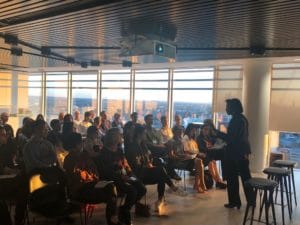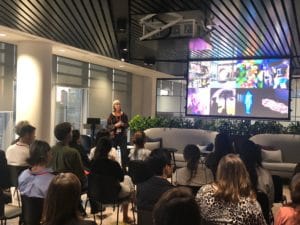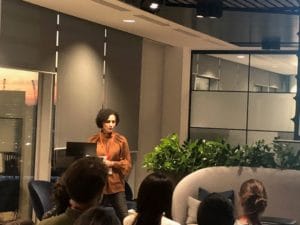Top Story
ULI UK Summer Drinks 2018 at Angel Court
This year’s ULI UK Summer Drinks on 25th July, was located at the hearth of the City, at Angel Court. The lounge on the 7th floor gives into
18 September 2018
Words by Chris Choa, ULI UK Chairman
The role that interactive art plays in engaging communities and making urban environments more engaging was discussed at a event organised by the ULI UK Urban Art Forum and kindly hosted by AECOM on 17th September. The discussions also highlighted the emerging importance of digital technology in expressive art.
 As a non-profit leader and long-standing patron of the arts, Juanita Hardy, ULI Senior Visiting Fellow for Creative Placemaking and former executive director of CulturalDC, has focused consistently on how to integrate arts and culture into development projects. Juanita outlined how traditional ‘placemaking’, which first emerged as an urban strategy closely associated with historical references, is evolving into ‘creative placemaking’. Art and related cultural programming increasingly animate major public spaces; together, they represent a strategy for urban regeneration and they also define emerging specialised communities. Juanita identified how art and cultural programming produce the economic dividends, and she mapped the attributes that motivated related stakeholder groups, including: visitors, investors, government, communities, developers, and of course the artists themselves. Juanita Hardy’s presentation.
As a non-profit leader and long-standing patron of the arts, Juanita Hardy, ULI Senior Visiting Fellow for Creative Placemaking and former executive director of CulturalDC, has focused consistently on how to integrate arts and culture into development projects. Juanita outlined how traditional ‘placemaking’, which first emerged as an urban strategy closely associated with historical references, is evolving into ‘creative placemaking’. Art and related cultural programming increasingly animate major public spaces; together, they represent a strategy for urban regeneration and they also define emerging specialised communities. Juanita identified how art and cultural programming produce the economic dividends, and she mapped the attributes that motivated related stakeholder groups, including: visitors, investors, government, communities, developers, and of course the artists themselves. Juanita Hardy’s presentation.
 Carla Rapoport abandoned a comfortable life in financial journalism to focus on her passion for digital art and artists. As the founder of the Lumen Prize and director of Lumen Art Projects, she has created the pre-eminent global platform for digital art. Her desire to recognise and implement the work of digital artists grew out of her journalistic scrutiny of tech. She noted how digital artists are almost universally cross-disciplinary, and she identified innovations in four major areas; urban regeneration, community growth, public space, and legacy/preservation. Carla underscored how interactive pieces engage with their surroundings in extraordinary ways. She also noted how the legacy for digital pieces is secured through study and research perhaps more than through collection as a commodity. Carla Rapoport’s Presentation.
Carla Rapoport abandoned a comfortable life in financial journalism to focus on her passion for digital art and artists. As the founder of the Lumen Prize and director of Lumen Art Projects, she has created the pre-eminent global platform for digital art. Her desire to recognise and implement the work of digital artists grew out of her journalistic scrutiny of tech. She noted how digital artists are almost universally cross-disciplinary, and she identified innovations in four major areas; urban regeneration, community growth, public space, and legacy/preservation. Carla underscored how interactive pieces engage with their surroundings in extraordinary ways. She also noted how the legacy for digital pieces is secured through study and research perhaps more than through collection as a commodity. Carla Rapoport’s Presentation.
 As a multi-cultural producer for a wide range of art publications and programs, Amira Gad has always been interested in how social practices inform artistic expression. The exhibitions curator for the Serpentine Galleries, Amira outlined how specialised programming and temporal events create ‘an open landscape for art and ideas’. She noted how performative events and the interactive nature of digital art are creating an emerging category of ‘social sculpture’. Serpentine work is displaced; entire temporary pavilions created for London are acquired by private collectors and move to new locations. The Serpentine model of temporary work and programming is itself mobile, with new cities like Beijing recreating the Serpentine system in new and culturally different contexts. Amira Gad’s Presentation.
As a multi-cultural producer for a wide range of art publications and programs, Amira Gad has always been interested in how social practices inform artistic expression. The exhibitions curator for the Serpentine Galleries, Amira outlined how specialised programming and temporal events create ‘an open landscape for art and ideas’. She noted how performative events and the interactive nature of digital art are creating an emerging category of ‘social sculpture’. Serpentine work is displaced; entire temporary pavilions created for London are acquired by private collectors and move to new locations. The Serpentine model of temporary work and programming is itself mobile, with new cities like Beijing recreating the Serpentine system in new and culturally different contexts. Amira Gad’s Presentation.
The ensuing discussions addressed a wide range of related issues, and some consensus began to form. Successful communities define intended outcomes before diving into their engagements with art and cultural programming. The ephemeral nature of interactive digital art challenges traditional notions of collect-ability, but also produces a longer-lasting and widespread legacy of evolved communities. Perhaps most interestingly, while the value of art is often determined by specialised curators and institutions, interactive digitally-enabled art expresses an enduring social contract between artist and community; perhaps no other land-use or activity is as free of the constrictions of social class or the limitations of territorial boundaries.
With thanks to our speakers, Amira, Carla and Juanita and our moderator, Chris Choa, AECOM.
Don’t have an account? Sign up for a ULI guest account.